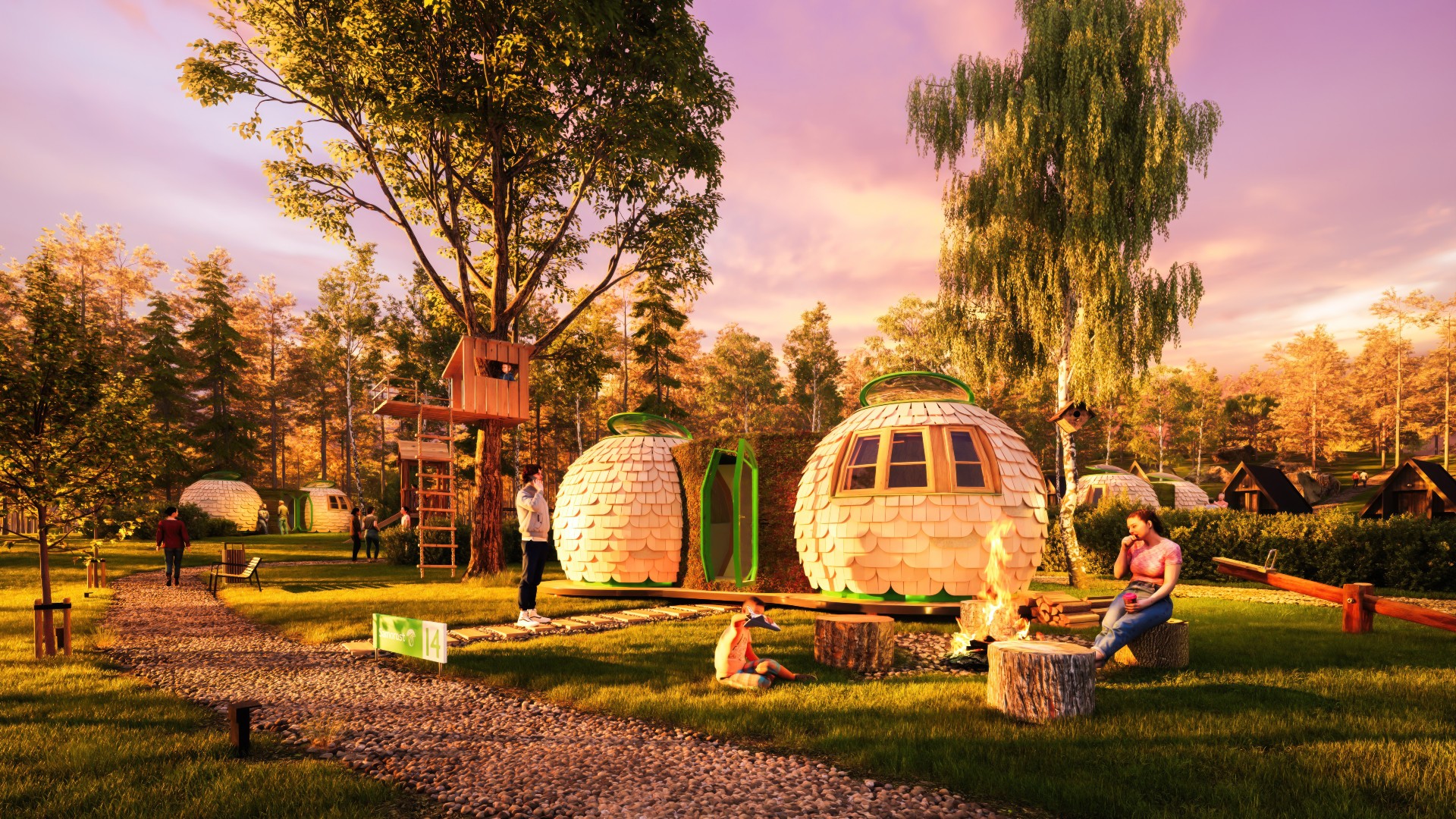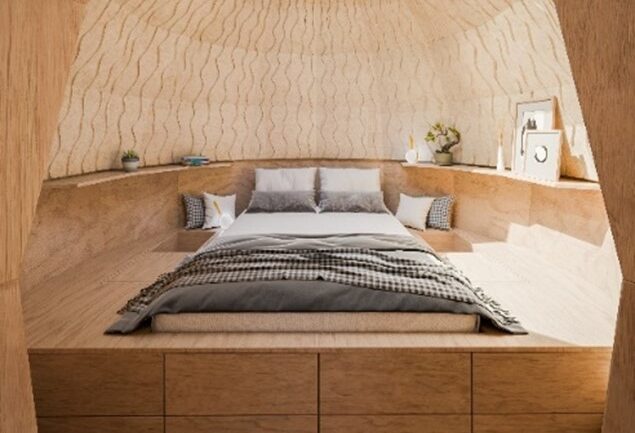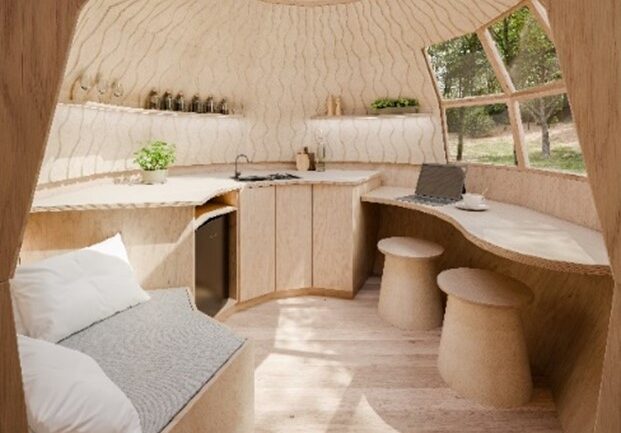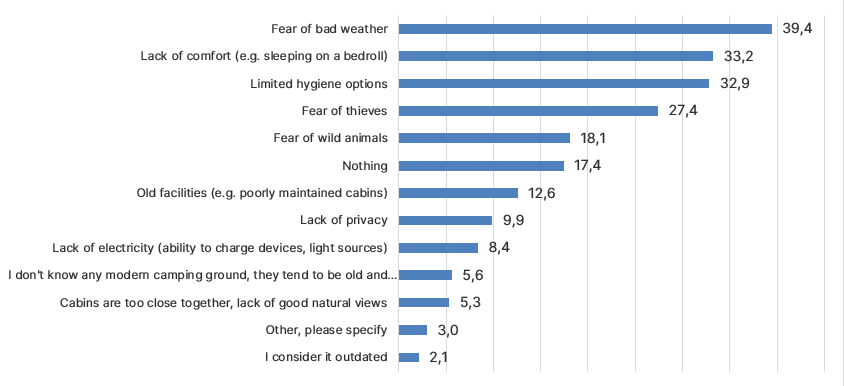The first building made of mycelium is growing in the Czech Republic. The SAMOROST experiment brings science fiction to reality.
The SAMOROST house, which is currently under construction in the Czech Republic, demonstrates different ways of using mycelium in sustainable construction. Laboratory tests carried out on samples of the mycocomposite have confirmed that the material is suitable, for example, for the insulation of external walls, as a non-load-bearing house structure, to eliminate thermal bridges or as a sound insulator. Mycocomposite has the potential to replace non-ecological materials commonly used in construction, such as polystyrene. The SAMOROST house visually resembles two parasol mushrooms growing in the wild. Mycelium is suitably complemented by other natural materials, especially wood. The interior is designed to be both impressive at first sight and as practical as possible. At this stage, the SAMOROST house represents the way of modern and sustainable camping, so-called glamping.

Mycelium in the construction industry is becoming reality
Laboratory tests carried out within the SAMOROST project during 2023 and early 2024 confirmed that the mycocomposite has properties suitable for use in construction. It has a great potential to replace non-organic materials commonly used in this area. “Already at the moment, a building is being built in the Czech Republic based on the mycelium of the reishi mushroom. In this way, the SAMOROST experiment wants to demonstrate all the possible uses of mycocomposite in sustainable construction. This innovative material can be used to insulate external walls, roofs and floors, as a non-load-bearing house structure, is suitable for eliminating thermal bridges and is an excellent sound insulator. In addition, it can be used to make modern furniture or decorations,” summarises Jakub Seifert, chairman of the MYMO Association, which is involved in SAMOROST together with building savings bank Burinka (meber of Erste group).
The SAMOROST experiment builds on successful innovative projects of building savings bank Burinka (meber of Erste group), such as Prvok or the 3D printed playground. “We have been supporting science and research in the field of construction and architecture for a long time. We are a bridge between the academic and commercial spheres. After 3D printing with concrete, a mycelium-based material caught our attention; as much as it seems like science fiction, we saw it as the building material of the future from the beginning. And that we were not wrong and took the right path is now confirmed,” says Libor Vošický, Chairman of the Board of building savings bank Burinka (meber of Erste group), the initiator and donor of the SAMOROST project. “The culmination of our efforts in 2023 was the exhibition of furniture and interior accessories made from mycocomposite at the international Designblok festival. This year we will build a house from mycelium,” adds Libor Vošický.
House from mycelium with windows to the sky
The author of the design is Tomasz Kloza, a member of the MYMO Association and a student of the final year of his Master’s degree in architecture and urbanism at the Faculty of Architecture of the Czech Technical University in Prague. He designed the house to resemble two parasol mushrooms with its organic shape and biophilic design. The construction system is based on simplicity. The main mycelium insulation is complemented by a wooden supporting structure.

|

|
“I wanted to imitate the appearance of parasol mushrooms growing in the wild as much as possible. Our ‚mushrooms‘ are divided into fourteen identical segments, which make the structure sort of a jigsaw puzzle. We added other natural and sustainable components to the mycelium to form a unique whole. For the roofing we chose wooden shingles that are segmented to resemble the individual flakes of the parasol mushroom’s cap. The shingles are complemented with decorative elements made of mycelium. We chose a green facade to connect the two living areas. The connection is less conspicuous and does not disturb the overall impression. The experience of the building is completed by round skylights that can be tilted. They are the central light source, windows to the sky and a view of flying clouds and shining stars,” says Tomasz Kloza.
An interior that dazzles with its beauty and practicality
The concept of the SAMOROST house allows for endless variations in the size of the „mushrooms“ as well as in their internal layout and function. At this stage, a template combination of a kitchen with seating in one mushroom and a bedroom in the other was chosen. The authors of the interior are Karolína Petřeková and Petra Jašicová from MYMO Association.
“Our intention was to use mycocomposite and other natural materials to make the interior space as practical as possible, but at the same time to evoke a feeling of nature combined with luxury and to captivate its visitors at first sight. The kitchen area contains a refrigerator and a gas cooker combined with a sink, which is fed with water from a barrel located in a cabinet under the kitchen countertop. In addition to the work surface, shelving and cupboards, there is space for seating and a dining area. The bedroom has a number of gadgets, from storage spaces to areas designed specifically for mobile phones, tablets, watches, etc.,” says Karolína Petřeková, and Patra Jašicová adds. „The energy for appliances, lighting and recharging equipment will be provided by a rechargeable battery. The heat supply for the colder periods is provided by electric space heaters. We also used mycocomposite as much as possible for the interior furnishings. It has such original properties and beautiful textures that it perfectly complements the modern design of the living spaces.”
“Our work has been supported by the Minister of the Environment Petr Hladík. The creation of the SAMOROST house from mycelium is therefore done under his patronage. I see this gesture as a huge moral support not only for our work, but also for the whole field of sustainable construction,” says Libor Vošický.
“The SAMOROST House will be ready at the end of this year. We will present a part of it, or a section of the house including the complete technical solution to the public at an experiential exhibition in the gallery of the National Technical Library. The model example of the house is set up as a habitable space, e.g. for more luxurious camping, so-called glamping. However, a building of this type will certainly find many more applications,” says Jakub Seifert.
SAMOROST House offers a new camping experience
According to the building savings bank Burinka (meber of Erste group) survey, what people appreciate most about camping is being close to nature (68%), it is also a way to escape everyday stress and monotony (52%), and for 48% of respondents it is an opportunity to spend time with family or friends and have shared experiences. And what discourages people from camping? It is mainly fear of bad weather (39%), lack of comfort (33%) and, to the same extent, limited conditions for hygiene. People also cited fears of thieves, wildlife and old facilities.
“SAMOROST House takes into account all the disadvantages or concerns people have expressed about camping. It is designed to take the experience to the next level. You won’t mind bad weather in a beautiful bed with a view of the sky, even if it’s cloudy. A well-designed interior will ensure plenty of comfort and a sink with water supply will in turn provide better sanitation. Staying in SAMOROST is safe, you can lock yourself from thieves and hide from possible wild animals. As a bonus, you will have plenty of privacy, comfort and hotel-like luxury,” says Tomasz Kloza.
The SAMOROST house is the ideal way to go for the increasingly popular glamping. The building savings bank Burinka (meber of Erste group) survey showed that 43% of people would like to try glamping, which combines classic camping with the advantages of hotels and their comfort.
What discourages you from camping

Who is MYMO
MYMO brings together personalities from the field of research who have set themselves the goal of laying the foundations of mycelial architecture in the Czech Republic. These are experts from the Institute of Model Design of the Faculty of Architecture of the Czech Technical University (Molab) and experts from the company Mykilio. For this purpose, Kateřina Sýsová, Karolína Petřeková, Petra Jašicová, Jiří Vele, Matěj Róth, Jakub Seifert and Tomasz Kloza are researching and developing a material based on mycelium. At the same time, together with Buřinka, they want to raise awareness of the potential of mycelium in construction among both the professional and general public.
About building savings bank Burinka (meber of Erste group)
For 30 years, it has been providing clients with advantageous building savings and housing loans, including comprehensive financial advice. Helping to turn a dwelling into a home. Current focus is on financing sustainable renovations. The reconstruction bank’s profile is reflected not only in its product and service offering, but also in its communication. The experience of renovating a foster home in Central Bohemia was translated by Buřinka into reconstruction guide. It is a sponsor of the programme “Action: Renovation” broadcast on Czech Television.
As a building society, it also feels a commitment to the construction industry, which it fulfils by supporting innovative processes and materials used in the construction of houses. For more information on our projects carried out to support science and research in the construction industry, please visit www.inovaceodburinky.cz/en/
Contact for media
Monika Kopřivová
External Communications Manager of building savings bank Burinka (meber of Erste group)
E-mail: monika.koprivova@burinka.cz
Mobile: +420 724 097 666
